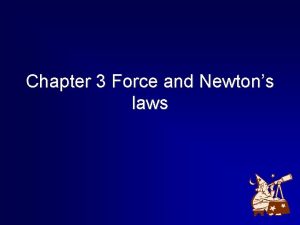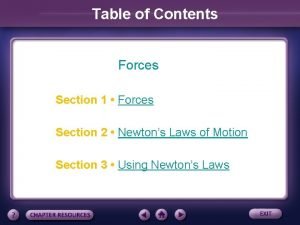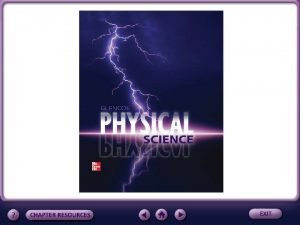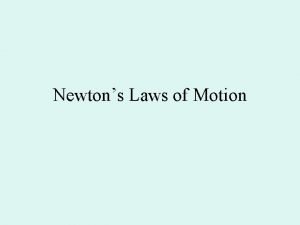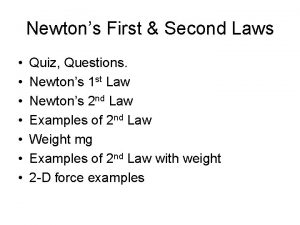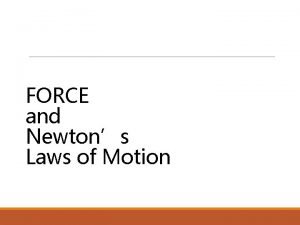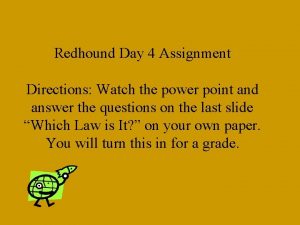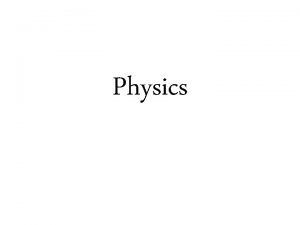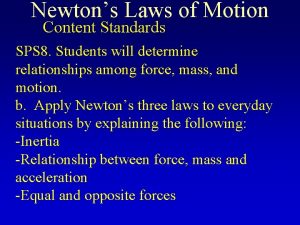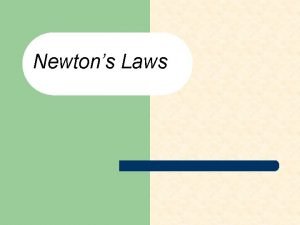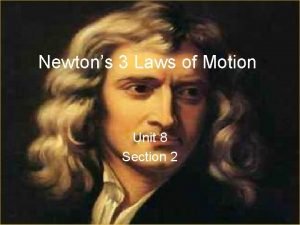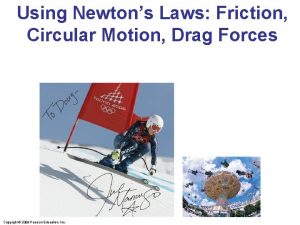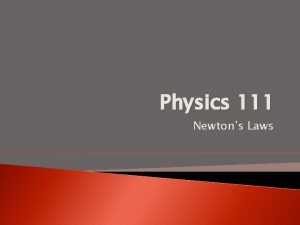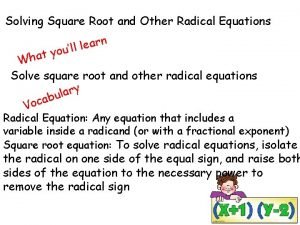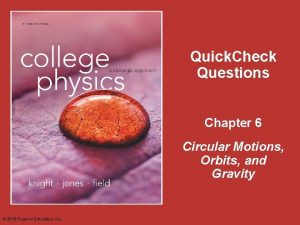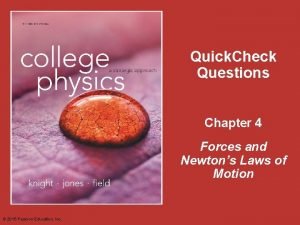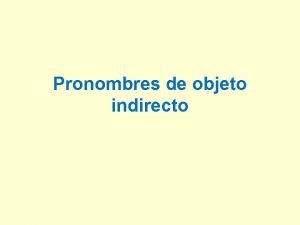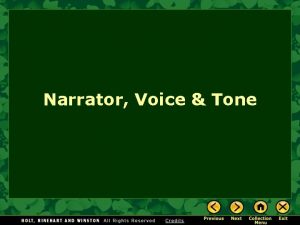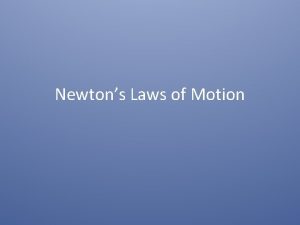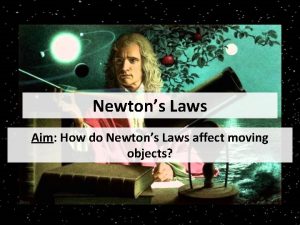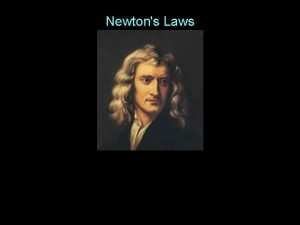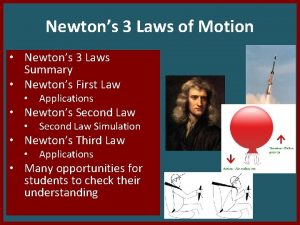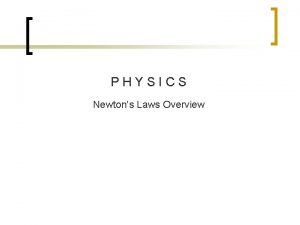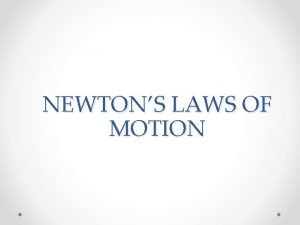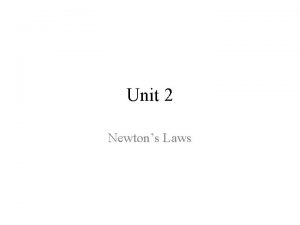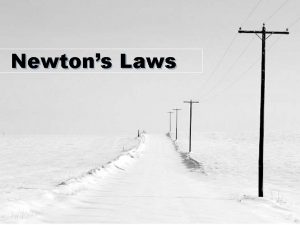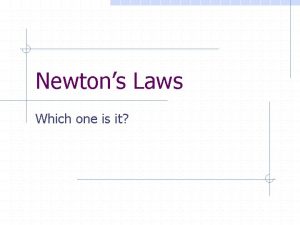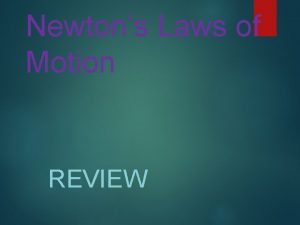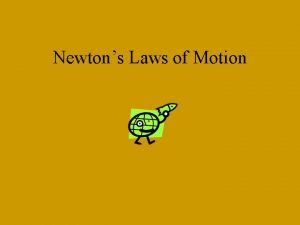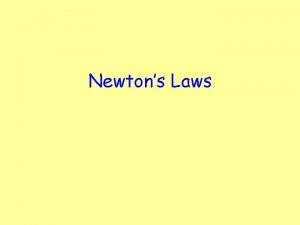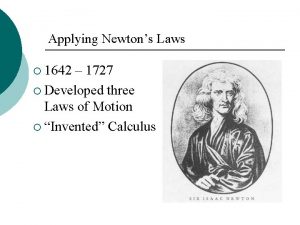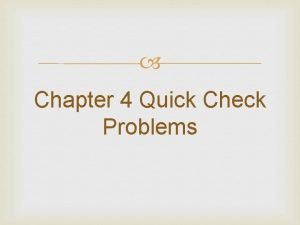Quick Check Questions Chapter 5 Applying Newtons Laws































- Slides: 31

Quick. Check Questions Chapter 5 Applying Newton’s Laws © 2015 Pearson Education, Inc.

Quick. Check 5. 1 A ring, seen from above, is pulled on by three forces. The ring is not moving. How big is the force F? A. B. C. D. E. 20 N 10 cos N 10 sin N 20 cos N 20 sin N © 2015 Pearson Education, Inc. Slide 5 -2

Quick. Check 5. 1 A ring, seen from above, is pulled on by three forces. The ring is not moving. How big is the force F? A. B. C. D. E. 20 N 10 cos N 10 sin N 20 cos N 20 sin N © 2015 Pearson Education, Inc. Slide 5 -3

Quick. Check 5. 2 The box is sitting on the floor of an elevator. The elevator is accelerating upward. The magnitude of the normal force on the box is A. B. C. D. E. n > mg n = mg n < mg n=0 Not enough information to tell © 2015 Pearson Education, Inc. Slide 5 -4

Quick. Check 5. 2 The box is sitting on the floor of an elevator. The elevator is accelerating upward. The magnitude of the normal force on the box is A. B. C. D. E. Upward acceleration requires a net upward force. n > mg n = mg n < mg n=0 Not enough information to tell © 2015 Pearson Education, Inc. Slide 5 -5

Quick. Check 5. 3 A box is being pulled to the right at steady speed by a rope that angles upward. In this situation: A. B. C. D. E. n > mg n = mg n < mg n=0 Not enough information to judge the size of the normal force © 2015 Pearson Education, Inc. Slide 5 -6

Quick. Check 5. 3 A box is being pulled to the right at steady speed by a rope that angles upward. In this situation: A. B. C. D. E. n > mg n = mg n < mg n=0 Not enough information to judge the size of the normal force © 2015 Pearson Education, Inc. Slide 5 -7

Quick. Check 5. 4 What are the components of shown? © 2015 Pearson Education, Inc. in the coordinate system Slide 5 -8

Quick. Check 5. 4 What are the components of shown? in the coordinate system D © 2015 Pearson Education, Inc. Slide 5 -9

Quick. Check 5. 5 A 50 -kg student (mg = 490 N) gets in a 1000 -kg elevator at rest and stands on a metric bathroom scale. As the elevator accelerates upward, the scale reads A. B. C. D. > 490 N < 490 N but not 0 N 0 N © 2015 Pearson Education, Inc. Slide 5 -10

Quick. Check 5. 5 A 50 -kg student (mg = 490 N) gets in a 1000 -kg elevator at rest and stands on a metric bathroom scale. As the elevator accelerates upward, the scale reads A. B. C. D. > 490 N < 490 N but not 0 N 0 N © 2015 Pearson Education, Inc. Slide 5 -11

Quick. Check 5. 6 A 50 -kg student (mg = 490 N) gets in a 1000 -kg elevator at rest and stands on a metric bathroom scale. Sadly, the elevator cable breaks. What is the reading on the scale during the few seconds it takes the student to plunge to his doom? A. B. C. D. > 490 N < 490 N but not 0 N 0 N © 2015 Pearson Education, Inc. Slide 5 -12

Quick. Check 5. 6 A 50 -kg student (mg = 490 N) gets in a 1000 -kg elevator at rest and stands on a metric bathroom scale. Sadly, the elevator cable breaks. What is the reading on the scale during the few seconds it takes the student to plunge to his doom? A. B. C. D. > 490 N < 490 N but not 0 N The bathroom scale would read 0 N. Weight is reading of a scale on which the object is stationary relative to the scale. © 2015 Pearson Education, Inc. Slide 5 -13

Quick. Check 5. 7 A box on a rough surface is pulled by a horizontal rope with tension T. The box is not moving. In this situation: A. B. C. D. E. fs > T fs = T fs < T fs = smg fs = 0 © 2015 Pearson Education, Inc. Slide 5 -14

Quick. Check 5. 7 A box on a rough surface is pulled by a horizontal rope with tension T. The box is not moving. In this situation: A. B. C. D. E. fs > T fs = T Newton’s first law fs < T fs = smg fs = 0 © 2015 Pearson Education, Inc. Slide 5 -15

Quick. Check 5. 8 A box with a weight of 100 N is at rest. It is then pulled by a 30 N horizontal force. Does the box move? A. Yes B. No C. Not enough information to say © 2015 Pearson Education, Inc. Slide 5 -16

Quick. Check 5. 8 A box with a weight of 100 N is at rest. It is then pulled by a 30 N horizontal force. Does the box move? A. Yes B. No 30 N < fs max = 40 N C. Not enough information to say © 2015 Pearson Education, Inc. Slide 5 -17

Quick. Check 5. 9 A box is being pulled to the right over a rough surface. T > fk, so the box is speeding up. Suddenly the rope breaks. What happens? The box A. Stops immediately. B. Continues with the speed it had when the rope broke. C. Continues speeding up for a short while, then slows and stops. D. Keeps its speed for a short while, then slows and stops. E. Slows steadily until it stops. © 2015 Pearson Education, Inc. Slide 5 -18

Quick. Check 5. 9 A box is being pulled to the right over a rough surface. T > fk, so the box is speeding up. Suddenly the rope breaks. What happens? The box A. Stops immediately. B. Continues with the speed it had when the rope broke. C. Continues speeding up for a short while, then slows and stops. D. Keeps its speed for a short while, then slows and stops. E. Slows steadily until it stops. © 2015 Pearson Education, Inc. Slide 5 -19

Quick. Check 5. 10 All three 50 -kg blocks are at rest. The tension in rope 2 is A. Greater than the tension in rope 1. B. Equal to the tension in rope 1. C. Less than the tension in rope 1. © 2015 Pearson Education, Inc. Slide 5 -20

Quick. Check 5. 10 All three 50 -kg blocks are at rest. The tension in rope 2 is A. Greater than the tension in rope 1. B. Equal to the tension in rope 1. C. Less than the tension in rope 1. Each block is in static equilibrium, with © 2015 Pearson Education, Inc. . Slide 5 -21

Quick. Check 5. 11 Consider the situation in the figure. Which pair of forces is an action/reaction pair? A. The tension of the string and the friction force acting on A B. The normal force on A due to B and the weight of A C. The normal force on A due to B and the weight of B D. The friction force acting on A and the friction force acting on B © 2015 Pearson Education, Inc. Slide 5 -22

Quick. Check 5. 11 Consider the situation in the figure. Which pair of forces is an action/reaction pair? A. The tension of the string and the friction force acting on A B. The normal force on A due to B and the weight of A C. The normal force on A due to B and the weight of B D. The friction force acting on A and the friction force acting on B © 2015 Pearson Education, Inc. Slide 5 -23

Quick. Check 5. 12 Boxes A and B are being pulled to the right on a frictionless surface; the boxes are speeding up. Box A has a larger mass than Box B. How do the two tension forces compare? A. B. C. D. T 1 > T 2 T 1 = T 2 T 1 < T 2 Not enough information to tell © 2015 Pearson Education, Inc. Slide 5 -24

Quick. Check 5. 12 Boxes A and B are being pulled to the right on a frictionless surface; the boxes are speeding up. Box A has a larger mass than Box B. How do the two tension forces compare? A. B. C. D. T 1 > T 2 T 1 = T 2 T 1 < T 2 Not enough information to tell © 2015 Pearson Education, Inc. Slide 5 -25

Quick. Check 5. 13 Boxes A and B are sliding to the right on a frictionless surface. Hand H is slowing them. Box A has a larger mass than Box B. Considering only the horizontal forces: A. B. C. D. FB on H = FH on B = FA on B = FB on A FB on H = FH on B > FA on B = FB on A FB on H = FH on B < FA on B = FB on A FH on B = FH on A > FA on B © 2015 Pearson Education, Inc. Slide 5 -26

Quick. Check 5. 13 Boxes A and B are sliding to the right on a frictionless surface. Hand H is slowing them. Box A has a larger mass than Box B. Considering only the horizontal forces: A. B. C. D. FB on H = FH on B = FA on B = FB on A FB on H = FH on B > FA on B = FB on A FB on H = FH on B < FA on B = FB on A FH on B = FH on A > FA on B © 2015 Pearson Education, Inc. Slide 5 -27

Quick. Check 5. 14 The two masses are at rest. The pulleys are frictionless. The scale is in kg. The scale reads A. 0 kg B. 5 kg C. 10 kg © 2015 Pearson Education, Inc. Slide 5 -28

Quick. Check 5. 14 The two masses are at rest. The pulleys are frictionless. The scale is in kg. The scale reads A. 0 kg B. 5 kg C. 10 kg © 2015 Pearson Education, Inc. Slide 5 -29

Quick. Check 5. 15 The top block is accelerated across a frictionless table by the falling mass m. The string is massless, and the pulley is both massless and frictionless. The tension in the string is A. T < mg B. T = mg C. T > mg © 2015 Pearson Education, Inc. Slide 5 -30

Quick. Check 5. 15 The top block is accelerated across a frictionless table by the falling mass m. The string is massless, and the pulley is both massless and frictionless. The tension in the string is A. T < mg B. T = mg C. T > mg © 2015 Pearson Education, Inc. Tension has to be less than mg for the block to have a downward acceleration. Slide 5 -31
 The fan blade is speeding up. what are the signs of
The fan blade is speeding up. what are the signs of Chapter 10 section 1 meiosis worksheet answer key
Chapter 10 section 1 meiosis worksheet answer key Newton's laws
Newton's laws Problem 3
Problem 3 Newtons 3 rd law
Newtons 3 rd law Third law of newton
Third law of newton Section 3 using newtons law
Section 3 using newtons law Section 3 using newtons laws
Section 3 using newtons laws Abcd8n
Abcd8n Newtons laws od motion
Newtons laws od motion Find the mass of a football player who weighs 1250 n
Find the mass of a football player who weighs 1250 n Newtons first lw
Newtons first lw Newton's first and second law quiz
Newton's first and second law quiz Newton's 3rd law example
Newton's 3rd law example Newtons three law
Newtons three law Newton's all laws
Newton's all laws Newtons 3 laws
Newtons 3 laws Newtons third law
Newtons third law Law of inertia example
Law of inertia example Newtons 3
Newtons 3 Newtons laws
Newtons laws Newton 3 law of motion
Newton 3 law of motion Laws of motion
Laws of motion Law of friction
Law of friction Ethan is dragging a bag of grass
Ethan is dragging a bag of grass Quick find algorithm
Quick find algorithm Equation for square root
Equation for square root A coin sits on a turntable
A coin sits on a turntable Newton's second law quick check
Newton's second law quick check Energy release quick check
Energy release quick check Complemento de objeto directo
Complemento de objeto directo Point of view and tone quick check
Point of view and tone quick check






